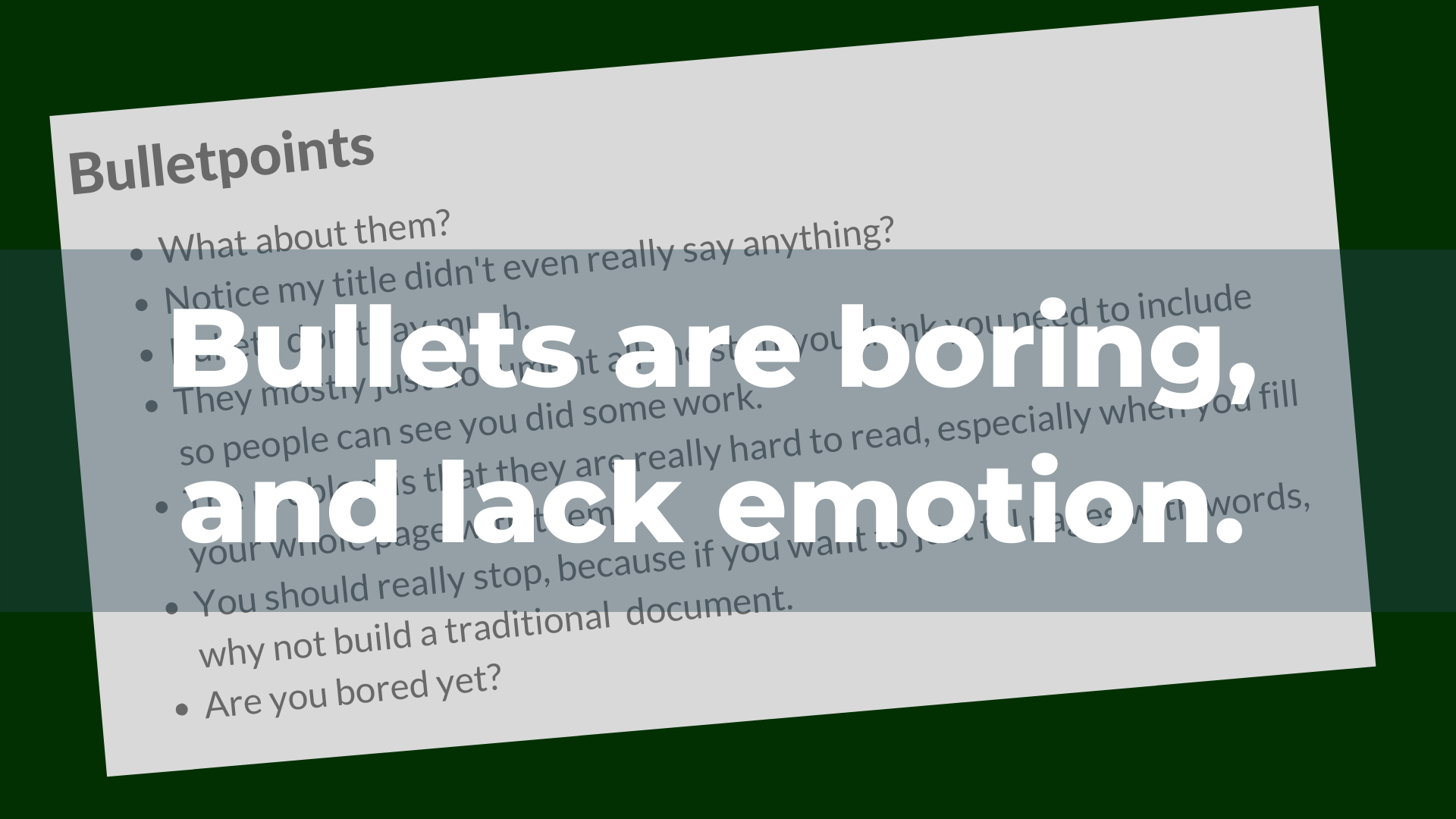powerpoint技巧
Almost 20 years ago — 2001! — Seth Godin wrote an ebook called Really Bad Powerpoint (and how to avoid it). In that book he detailed all of the things that tend to go wrong in slide presentations.
差不多20年前-2001年! —塞斯·戈丁(Seth Godin)写了一本名为《 真的很糟糕的Powerpoint》 (以及如何避免它)的电子书。 在那本书中,他详细介绍了幻灯片演示中容易出错的所有方面。
Everyone creates presentations with the right intent — to communicate something of importance to a group of people. But then we do all sorts of dumb things to undermine their communication, don’t we? Like jamming it with bullet points so it can serve as a teleprompter, or throwing in every factoid we’ve learned about the topic to anticipate (and ward off) questions. Sometimes we want to manage or even mitigate conversation. And sometimes, we create them simply because we were told that we should.
每个人都有正确的意图创建演示文稿-与一群人交流重要的事情。 但是,然后我们做各种愚蠢的事情来破坏他们的交流,不是吗? 就像用项目符号将其塞住一样,它可以用作提词提示器,或者将我们已经学习过的有关该主题的所有拟事实扔进去,以预测(并避开)问题。 有时我们想管理甚至减轻对话。 有时,我们创建它们的原因仅仅是因为我们被告知我们应该这样做。
On the very first page of Godin’s ebook, he says “Almost every PowerPoint presentation sucks rotten eggs.” And that was nineteen years ago!
他在Godin电子书的第一页上说:“ 几乎每个PowerPoint演示文稿都烂蛋。 ”那是19年前!
Here we are in 2020 and PowerPoint is just as prevalent as it was in 2001 and yet, for the most part, presentations have not gotten better. There are companies that have tried to help people make better presentations. Keynote was made specifically for Steve Jobs keynote presentations. Haiku Deck encouraged folks to remember that ‘less is more’, followed quickly by Prezi which seemed like a revelation for a moment in time — encouraging people to take their audience on a journey on an infinite canvas. All of these were born from the right intent — make better slides so you can tell better stories. In other words, get people to communicate better, and to create slides that don’t suck.
现在是2020年,PowerPoint与2001年一样流行,但是在大多数情况下, 演示文稿并没有变得更好 。 有些公司试图帮助人们做出更好的演示。 主题演讲专门针对史蒂夫·乔布斯的主题演讲。 Haiku Deck鼓励人们记住“少即是多”,紧随其后的是Prezi,这似乎是一段时间内的一次启示-鼓励人们在无限的画布上带动观众。 所有这些都是出于正确的意图而生的–制作更好的幻灯片,以便您讲更好的故事。 换句话说,让人们更好地沟通,并制作不会吸引人的幻灯片。

So what’s the problem? Because in most cases, Powerpoints continue to be uninspired, boring artifacts of the work, work, work. In fact, if you’ve spent any time in a sprawling corporate environment with layers upon layers of management, you’re probably very familiar with ‘rounds of revision’. We create our slides, and then revise, revise, revise as each member of the audience spends valuable time trying to tell you how to say it the way they would say it before it gets kicked on down the line. It can make it feel like your job is PowerPoint rather than thing that PowerPoint is supposed to communicate.
所以有什么问题? 因为在大多数情况下,Powerpoint仍然不受启发,是工作,工作,工作的无聊产物 。 实际上,如果您花了很多时间在庞大的企业环境中,并进行了层层管理,那么您可能对“轮次修订”非常熟悉。 我们创建幻灯片,然后修改,修改,修改,因为观众的每个成员都花费宝贵的时间试图告诉您如何用他们说的方式说出来,然后才能开始。 它会让您觉得您的工作是PowerPoint,而不是PowerPoint应该传达的东西。
We can do better.
我们可以做得更好。

大多数幻灯片演示应具有变革性,但它们都是事务性的。 (Most slide presentations are transactional when they should be transformational.)
Slide presentations are meant to help us communicate. They shouldn’t be simply a container for facts and figures. They have the power to change how we understand the world, our companies, and our work. They can illuminate problems, and how we might solve them. They can inspire, instruct, and persuade action. But far too often, we forget to infuse the presentation with the emotion that we feel as we’re preparing it.
幻灯片演示文稿旨在帮助我们进行交流。 它们不应仅仅是事实和数据的容器。 他们有权改变我们对世界,我们的公司和我们的工作的了解 。 它们可以阐明问题以及我们如何解决它们。 他们可以激发,指导和说服行动。 但是很多时候,我们忘了给演示文稿注入准备时的感觉。
Here’s what Seth Godin pointed out in 2001 that was lost on most people. We have two sides of our brain. One (the left side) is the rules-based, rational side. The other (the right side) is the creative, emotional side. The reason we have two sides is because we need both to survive. We need both logic and emotion. Logic discerns there is a lion lurking in the brush; emotion says, ‘freeze, don’t flee!’. We need both logic and emotion in life, and we need them both in our presentation slides too. Here’s how you can do that.
塞斯·戈丁(Seth Godin)在2001年指出的这一点对大多数人来说是迷路的。 我们的大脑有两个方面 。 一个(左侧)是基于规则的理性方面 。 另一面(右侧)是创造力,情感方面 。 我们有两个方面的原因是因为我们都需要生存。 我们需要逻辑和情感。 逻辑发现刷子中潜伏着一只狮子。 情感说:“冻结,不要逃跑!”。 生活中我们既需要逻辑又需要情感, 在演示幻灯片中我们也需要逻辑和情感。 这是您可以执行的操作。

使用视觉效果刺激情绪。 (Use visuals to stimulate emotion.)
But first, let’s think about why slide presentations exist in the first place. Why not a plain old document? And why the horizontal orientation?
但是首先,让我们考虑一下为什么幻灯片演示首先存在。 为什么不使用普通的旧文件? 以及为什么水平方向?
When slide software was invented, slides were intended to be viewed more like photographs which, before the smartphone, were almost always in a 4x3 (4 wide by 3 high) orientation. They were literal slides in a slide carousel that projected onto screens. Now you’ll often see 16x9 slides — wide format. And still, some folks can’t take the hint. They will fill that panorama with words and sentences so wide that you practically have to turn your head left to right repeatedly like a tennis umpire perched in her chair.
当发明了幻灯片软件时,幻灯片的观看目的更像是照片,在智能手机之前,幻灯片几乎总是以4x3(4宽x 3高)的方向放置。 它们是投影在屏幕上的幻灯片轮播中的文字幻灯片 。 现在,您将经常看到16x9幻灯片-宽幅。 仍然,有些人无法接受提示。 他们将在宽广的全景图中填充如此广泛的单词和句子,以至于您几乎不得不反复地左右摇头,就像坐在椅子上的网球裁判一样。

Now think. What are screens used for in virtually every other context? Stories! Visual stories.
现在想想。 几乎在所有其他情况下,屏幕都有什么用? 故事! 视觉故事。
Okay, so what exactly should you be doing with your slides? What does a ‘homerun’ slide presentation look like? Here’s what Seth Godin said:
好的,那么您应该如何使用幻灯片? “本垒打”幻灯片演示是什么样的? 这是塞思·戈丁(Seth Godin)所说的:
The home run is easy to describe: You put up a slide. It triggers an emotional reaction in the audience. They sit up and want to know what you’re going to say that fits in with that image. Then, if you do it right, every time they think of what you said, they’ll see the image (and vice versa).
本垒打很容易描述:您放了一张幻灯片。 它引起观众的情绪React 。 他们坐起来,想知道你要说的是什么与那个形象吻合。 然后,如果您做对了,每当他们想到您说的内容时,他们都会看到图像 (反之亦然) 。
If you want to see how to do this really really well, just look to children's books.
如果您想真正真正地做到这一点,请阅读儿童读物。
The Cat In The Hat
帽子里的猫
- The Giving Tree 给树
- Winnie the Pooh 维尼熊
- Where The Wild Things Are 野外之物

If you’ve read any of those books, and chances are you have, what did you conjure up just now? Pictures. Your memory just flooded your mind with images to help you access the content of the book. Children’s books could teach us all something about presenting. Some of the most memorable children’s books are lean on words and big on visuals. The story is told in clear and simple language with visuals that provide a jumping off point into your own imagination. And there’s another thing. You felt something too, didn’t you?
如果您已阅读其中任何一本书,并且有机会,您刚才想到了什么? 图片。 您的记忆力充斥着图像,以帮助您访问本书的内容。 儿童读物可以教给我们有关展示的所有知识。 一些最令人难忘的儿童读物偏向于文字,而视觉效果却很大。 故事以清晰明了的语言讲述, 并带有视觉效果 ,使您跳入自己的想象空间。 还有另一件事。 你也有感觉,不是吗?
In a research study published in Frontiers in Psychology about the link between emotions and memory, one research team found that “Emotion has a substantial influence on the cognitive processes in humans, including perception, attention, learning, memory, reasoning, and problem solving.”* Another team at MIT found that “memory improves when they are shown a higher percentage of memorable images.”* And, in the only study I could find specifically about presentation visuals, the researchers concluded that “Perceptions of the presenter as well as audience attention, comprehension, yielding, and retention are enhanced when presentation support (imagery) is used compared to when it is not. Presentations using visual aids were found to be 43% more persuasive than unaided presentations.”
在《 心理学前沿》上发表的一项关于情绪与记忆之间联系的研究中,一个研究小组发现:“情绪对人类的认知过程具有重大影响,包括感知,注意力,学习,记忆,推理和解决问题的能力。 ” *麻省理工学院的另一个团队发现,“当向人们展示更高比例的令人难忘的图像时,记忆会有所改善。” *而且,在我可以专门找到的有关演示视觉效果的唯一研究中 ,研究人员得出的结论是:“与演示支持相比,使用演示支持( 图像 )可以提高演示者的感知以及观众的注意力,理解力,屈服力和保留力”不是。 发现使用视觉辅助工具的演示比没有辅助的演示更有说服力43%。 ”
使用讲故事进行说服并促使人们采取行动。 (Use storytelling to persuade and get people to take action.)
But using visuals isn’t the whole story. In fact, to be effective in a presentation you must tell a story. Visuals are simply the mind’s container that will make that story memorable. To tell a great story, you need a basic story structure. And what is a story exactly? A story is the narration of a journey from some place to another. It’s a telling of a sequence of events that lead you from one stop on the journey to the next. And that’s what you need to capture in your presentation. What journey are you taking your audience on? A quick and easy way to set up a story is with this 3-part story structure.
但是,使用视觉效果并不是全部。 实际上,要使演示文稿有效,您必须讲一个故事。 视觉仅仅是头脑的容器,它将使这个故事令人难忘。 要讲述一个伟大的故事,您需要一个基本的故事结构。 故事到底是什么? 故事是从某个地方到另一个地方的叙述。 这说明了一系列事件,这些事件导致您从旅程的下一站到下一站。 这就是您需要在演示文稿中捕获的内容。 您是如何带领观众的? 通过一个三部分的故事结构 ,可以快速轻松地建立故事。
Context — What’s the situation now? What’s the ‘current state’ and if needed, the background on how you got here. Ex. Our sales suck, and we need to fix that.
上下文 -现在情况如何? 什么是“当前状态”,如果需要的话,还有您到达这里的背景。 例如 我们的销售不好,我们需要解决这个问题。
Complication — What’s stopping you (or your audience) from moving forward? What is the obstacle? Is it an external villain (ex. Our competition is eating our lunch because . . . ); or is it something more nefarious (ex. The processes we’ve put in place have become so convoluted we’re spending more time managing our processes than creating a great product.)
并发症 -是什么在阻止您(或您的听众)前进? 有什么障碍? 是外部的恶棍吗(例如, 我们的竞争是因为 …… 而吃了午餐 ); 还是更邪恶(例如,我们已经建立的流程变得如此复杂,我们花费更多的时间来管理流程,而不是创造出出色的产品。)
Resolution — What do you suggest doing about it?
解决方法 –您对此有何建议?

提出要求。 (Make the ask.)
One of the silliest mistakes that people make when giving presentations is wrapping things up before making a request. Think about why you’re there. Is it to ask for funding, get agreement on the next step of a project, get political buy-in on a new initiative, to point out a problem that is worth solving? You absolutely must get very clear about what it is that you want from your audience. If you didn’t need anything from them, there wouldn’t be a presentation in the first place. Sometimes you have an explicit ‘call to action’ (CTA), and sometimes it’s more nuanced.
人们在做演示时犯的最严重的错误之一就是在提出请求之前先将其包装好。 想想你为什么在那里。 是要寻求资金,就项目的下一步达成协议,就一项新倡议获得政治支持,还是要指出一个值得解决的问题? 您绝对必须非常清楚观众想要什么 。 如果您不需要他们提供任何帮助,那么首先不会进行演示。 有时您会有明确的“号召性用语”(CTA),有时则更为细微。
Explicit: ‘We need your approval to move this project to the next step.” Do you approve?
明确: “我们需要您的批准才能将该项目移至下一步。” 你赞成吗
Implicit: If we don’t solve this problem, this project will take twice as long as it should. Do you want me to tell you how to solve the problem? Or Do you want to divert resources to solving the problem?
隐式: 如果我们不解决此问题,则该项目将花费应有时间的两倍。 您要我告诉您如何解决问题吗? 要么 您是否要转移资源来解决问题?
If there isn’t an opening for a discussion, why go through the effort of assembling an audience? Create that opening by making your ask. It could be as simple as ‘is this in line with your expectations?’
如果没有讨论的余地,为什么还要努力吸引观众呢? 通过提出要求来创建该开口。 可能很简单,例如“这符合您的期望吗?”

That request is really an invitation, and it’s all about taking your presentation from transactional to transformational. If you get good at this, you may well find that you’ve even transformed your audience’s perception of you into someone they can’t do without.
该请求实际上是一个邀请 ,而这一切都是关于将您的演示文稿从事务性转变为变革性的。 如果您擅长于此,那么您可能会发现自己甚至已经将听众对您的看法转变为他们离不开的人。
结语 (Wrapping Up)
Next time you sit down to prepare some slides, ask yourself:
下次您坐下来准备一些幻灯片时,请问自己:
What do I have to say and why should they care? Get in touch with that before you start banging the keys.
我要说什么,他们为什么要关心呢? 开始敲键之前,请与您取得联系。
Now, what do you want them to feel? Notice the pictures that come to mind, or maybe doodle a few to activate that part of your brain. Pretend you’re writing a children’s book.
现在, 您希望他们有什么感觉? 请注意出现的图片,或者涂鸦一些以激活大脑的该部分。 假设您正在写儿童读物。
Now, without writing a novel, jot down the context, complication, and resolution. You should easily be able to get each on a sticky note.
现在,不用写小说,记下上下文,复杂性和解决方案 。 您应该可以轻松地将每个粘贴在便笺上。
Finally, what are you asking for? Don’t forget to make your ask and get an answer.
最后, 您要什么? 不要忘记提出您的要求并得到答案。
Here’s the whole thing in a quickie deck I made in Canva.
这是我在Canva制作的快速装甲板中的全部内容。
Got all that done? Now you’re ready to start making a presentation that is less likely to suck. And if you can’t do that, think about rescheduling the meeting.
完成所有这些了吗? 现在,您可以开始进行不太可能吸引人的演示了。 如果您做不到,请考虑重新安排会议时间。
If all you want to do is create a file of facts and figures, then cancel the meeting and send in a report. — Seth Godin.
如果您要做的只是创建事实和数据文件,则取消会议并发送报告。 塞斯·戈丁(Seth Godin)。
翻译自: https://uxdesign.cc/almost-every-powerpoint-sucks-rotten-eggs-24d806156bf0
powerpoint技巧





















 1034
1034

 被折叠的 条评论
为什么被折叠?
被折叠的 条评论
为什么被折叠?








